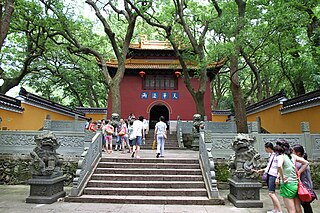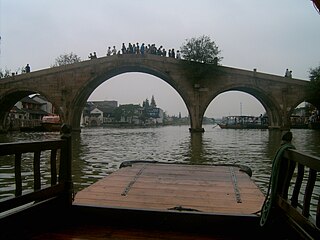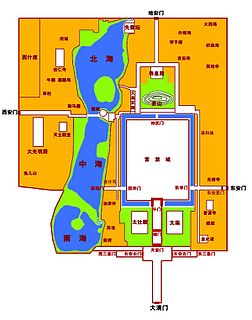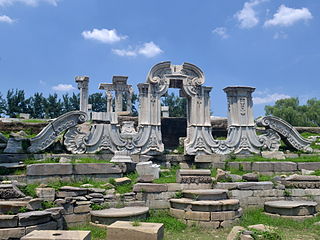 W
WArchitecture of Jiangxi refers to the traditional masonry houses, residential compounds, monuments, and academies built in Jiangxi of East China.
 W
WThe Banruo Temple, also pronounced Bore, is a Buddhist temple located in Shenhe District of Shenyang, Liaoning, China. The temple occupies an area of 1,000-square-metre (11,000 sq ft) and the total area including temple lands, forests and mountains is over 3,600-square-metre (39,000 sq ft). It is a Bhikkhuni temple.
 W
WThe Belvedere of Literary Profundity, Wenyuan Ge or Wenyuan Library is a palace building in the Forbidden City in Beijing.
 W
WChengde Mountain Resort in Chengde, is a large complex of imperial palaces and gardens situated in the Shuangqiao District of Chengde in northeastern Hebei province, northern China, about 225 km northeast of Beijing. This resort was frequently used as a summer palace during the Qing dynasty. Because of its vast and rich collection of Chinese landscapes and architecture, the Mountain Resort in many ways is a culmination of all the variety of gardens, pagodas, temples and palaces from various regions of China. In 1994, The Mountain Resort was awarded World Heritage Site status.
 W
WThe Former Residence of Deng Xiaoping was built in the late Qing dynasty. It is located in Paifang Village of Xiexing Town, Guang'an District, Guang'an City, Sichuan, China. It has a building area of about 833.4 m2 (8,971 sq ft), embodies buildings such as the old houses, the statue of Deng Xiaoping, the Dezheng Place (德政坊), the Cultural relics Exhibition Hall, the Hanlin Yard (翰林院子).
 W
WFayu Temple, also called Stone Temple, is one of three major temples in Mount Putuo, Zhejiang, China. Its grand hall was rebuilt in 1699 during the Qing dynasty (1644–1911).
 W
WThe Former Residence of Ding Richang was built in 1878, during the late Qing dynasty (1644–1911). It was the mansion of Ding Richang, a senior official in the Qing court.
 W
WThe Fragrant Hills Pagoda of the Fragrant Hills in Beijing, China was built in 1780 during the reign of the Qianlong Emperor (1735–1796) as part of the Grand Zongjing Monastery. Although the monastery located just north of the pagoda was burned down by the Eight-Nation Alliance in 1900, the Fragrant Hills Pagoda was unharmed by the nearby fires. The pagoda is octagonal-shaped, 40 m (130 ft) tall with seven stories, and has a stone square-platform at the base to support the structure. The pagoda is adorned with glazed tiles of yellow, green, purple, and blue hues. Surrounding the pagoda at the base is a wooden Chinese pavilion with supporting columns, this structure crowned with a white marble railing and terrace.
 W
WThe Free Life Bridge is a historic stone arch bridge over the Cao Port in Zhujiajiao, Qingpu District, Shanghai.
 W
WThe Fuling or Fu Mausoleum, also known as the East Mausoleum, is the mausoleum of Nurhaci, the founding monarch of the Later Jin dynasty and his wife, Empress Xiaocigao. It served as the main site for ritual ceremonies conducted by the imperial family during the entire Qing dynasty. Located in the eastern part of Shenyang city, Liaoning Province, northeastern China, Fuling has been a UNESCO World Heritage Site since 2004.
 W
WThe Gate of China was a historical ceremonial gateway in Beijing, China, located near the center of latter-day Tiananmen Square. It was demolished in 1954. This gate formed the southern gate of the Imperial City during the Ming and Qing dynasties. It was situated on the central axis of Beijing, to the north of Zhengyang Gate, and south of Tiananmen. Unlike these two defensive gates, the Gate of China was a purely ceremonial gateway, with no ramparts, but was a brick-stone structure with three gateways.
 W
WThe Gate of Divine Might or Gate of Divine Prowess is the northern gate of the Forbidden City in Beijing, China.
 W
WThe Gate of Supreme Harmony is the second major gate in the south of the Forbidden City in Beijing, China.
 W
WThe Guanghui Bridge is a historic stone arch bridge over the Nanshi River in Nanxun, Huzhou, Zhejiang, China. In is backed by the Taoist temple Guanghui Palace.
 W
WThe Hall of Central Harmony is one of the three halls of the Outer Court of the Forbidden City, in Beijing, China, along with the Hall of Supreme Harmony and Hall of Preserving Harmony. It is smaller than the other two halls, and is square in shape. It was used by the Emperor to prepare and rest before and during ceremonies.
 W
WThe Hall of Mental Cultivation is a building in the inner courtyard of the Forbidden City in Beijing, China. The Hall is a wooden structure with dome coffered ceilings, and was first built in the Ming dynasty in 1537, and was reconstructed in the Qing dynasty. During the early Qing Dynasty under the reign of the Kangxi Emperor the Hall was mostly used as a Workshop, wherein artisan objects like clocks were designed and manufactured. From the reign of the Yongzheng Emperor during the 18th century, the Hall was the residence for the emperor. Under the reign of the Qianlong Emperor until the fall of the Qing dynasty, the Hall became the centre of governance and political administration. In the Western Warmth Chamber, the Emperor would hold private meetings, and discuss state affairs with his mandarins. After the death of Emperor Xianfeng, from inside the Eastern Warmth Chamber, empress dowagers Ci'an and Cixi would hold audiences with ministers and rule from behind a silk screen curtain during their regencies for emperors Tongzhi and Guangxu, who both succeeded to the throne as children in the second half of the 19th century.
 W
WThe Hall of Supreme Harmony is the largest hall within the Forbidden City in Beijing, China. It is located at its central axis, behind the Gate of Supreme Harmony. Built above three levels of marble stone base, and surrounded by bronze incense burners, the Hall of Supreme Harmony is one of the largest wooden structures within China. It was the location where the emperors of the Ming and Qing dynasties hosted their enthronement and wedding ceremonies. The name of the Hall was changed several times throughout the past few centuries, from its initial Fengtian Dian (奉天殿), later to Huangji Dian (皇极殿) in 1562 and to the current one by the Shunzhi Emperor of the Qing dynasty in 1645.
 W
WThe Hall of Union is a building in the Forbidden City, in Beijing, China. It stands between the Palace of Heavenly Purity and the Palace of Earthly Tranquility. These three halls together constitute the centre of the Inner Court of the palace complex.
 W
WHongcun is a village in Hongcun Town, Yi County, Huangshan City in the historical Huizhou region of southern Anhui Province, China, near the southwest slope of Mount Huangshan.
 W
WThe Hongji Bridge is a historic stone arch bridge over the Dongshi River in Nanxun, Huzhou, Zhejiang, China.
 W
WThe Huairen Hall or Huairentang is a building inside Zhongnanhai, the Chinese government's leadership compound in Beijing. It has been the site of several major events in Chinese history. Huairen Hall is the main meeting place of the Politburo of the Communist party of China and an alternate meeting place of the Standing Committee. The building is also the meeting location of several of the Communist Party's leading groups such as the Financial and Economic Affairs Leading Group and the Leading Group for Comprehensively Deepening Reforms.
 W
WThe Imperial City is a section of the city of Beijing in the Ming and Qing dynasties, with the Forbidden City at its center. It refers to the collection of gardens, shrines, and other service areas between the Forbidden City and the Inner City of ancient Beijing. The Imperial City was surrounded by a wall and accessed through seven gates and it includes historical places such as the Forbidden City, Tiananmen, Zhongnanhai, Beihai Park, Zhongshan Park, Jingshan, Imperial Ancestral Temple, and Xiancantan.
 W
WJing'an Temple is an esoteric Tangmi Buddhist temple on the West Nanjing Road in Shanghai. Jing'an District, where it is located, is named after the temple.
 W
WThe Marco Polo Bridge or Lugou Bridge is a stone bridge located 15 km southwest of Beijing's city center in the Fengtai District. It bridges the Yongding River, a major tributary of Hai River. Situated at the eastern end of the bridge is the Wanping Fortress, a historic 17th-century fortress, with the Museum of the War of Chinese People's Resistance Against Japanese Aggression inside.
 W
WThe Meridian Gate or Wumen is the southern and largest gate of the Forbidden City in Beijing, China. Unlike the other gates of the Forbidden City, the Meridian Gate has two protruding arms on either side, derived from ancient que towers traditionally used to decorate the main entrances of palaces, temples and tombs. The gate has five arches. The three central arches are close together in the main, central section; the two flanking arches are farther apart from the three central arches, and are located between the central section and the protruding arms. The centre arch was formerly reserved for the Emperor alone; the exceptions were the Empress, who could enter it once on the day of her wedding, and the top three scholars of the triennial civil service examinations, who left the exams through the central arch. All other officials and servants had to use the four side arches.
 W
WThe Mukden Palace, or Shenyang Imperial Palace, was the former imperial palace of the early Manchu-led Qing dynasty. It was built in 1625, and the first three Qing emperors lived there from 1625 to 1644. Since the collapse of imperial rule in China, the palace has been converted to a museum that now lies in the center of Shenyang, Liaoning.
 W
WThe Old Summer Palace, known in Chinese as Yuanming Yuan, originally called the Imperial Gardens, and sometimes called the Winter Palace, was a complex of palaces and gardens in present-day Haidian District, Beijing, China. It is 8 kilometres (5.0 mi) northwest of the walls of the former Imperial City section of Beijing. Widely perceived as the pinnacle work of Chinese imperial garden and palace design, the Old Summer Palace was known for its extensive collection of gardens, its building architecture and numerous art and historical treasures. Constructed throughout the 18th and early 19th centuries, the Old Summer Palace was the main imperial residence of Qianlong Emperor of the Qing dynasty and his successors, and where they handled state affairs; the Forbidden City was used for formal ceremonies. It was reputed as the "Garden of Gardens" in its heyday.
 W
WThe Pagoda of Chengtian Temple, meaning 'Bearing Heaven Pagoda', is an eleven-storeyed brick pagoda located on the site of a previous Buddhist temple in Yinchuan city, Ningxia, China. The pagoda was originally built during the Western Xia, but the current structure dates to the Qing dynasty. At 64.5 metres (212 ft) in height it is the tallest pagoda in Ningxia. In contrast to the Haibao Pagoda in Yinchuan, which is known as the Northern Pagoda, Chengtian Temple Pagoda is also informally referred to as the Western Pagoda.
 W
WThe Palace of Earthly Tranquility is the northernmost of the three main halls of the Inner Court of the Forbidden City in Beijing, China. The other two halls are the Palace of Heavenly Purity and Hall of Union.
 W
WThe Palace of Heavenly Purity, or Qianqing Palace is a palace in the Forbidden City in Beijing, China. It is the largest of the three halls of the Inner Court, located at the northern end of the Forbidden City. During the Qing dynasty, the palace often served as the Emperor's audience hall, where he held council with the Grand Council.
 W
WThe Puji Bridge is a historic stone arch bridge over the Shantang River in the Gusu District of Suzhou, Jiangsu.
 W
WThe Puning Temple, commonly called the Big Buddha Temple, is a Buddhist temple complex in Chengde, Hebei province, China. It was built in 1755 during the reign of the Qianlong Emperor in the Qing dynasty. It is near the Chengde Mountain Resort and alongside the equally famed Putuo Zongcheng Temple. Puning is one of the "Eight Outer Temples" of Chengde.
 W
WThe Putuo Zongcheng Temple of Chengde, Hebei province, China is a Qing dynasty era Buddhist temple complex built between 1767 and 1771, during the reign of the Qianlong Emperor (1735–1796). It is located near the Chengde Mountain Resort, which is south of the Putuo Zongcheng. Along with the equally famed Puning Temple, it is one of the Eight Outer Temples of Chengde. The temple was modeled after the Potala Palace of Tibet, the residence of the Dalai Lama built a century earlier. Since it was modeled after the Potala palace, the temple represents a fusion of Chinese and Tibetan architectural styles. The temple complex covers a surface area of some 220,000 square metres (2,400,000 sq ft), making it one of the largest in China. Many of its halls and pavilions are adorned with copper and gold tiled roofs, adding to the splendor of the site.
 W
WQinghua Rainbow Bridge was a large stone beam bridge in the town of Qinghua, Wuyuan County, Jiangxi, China. The bridge went across the Le'an River. The bridge was 140 m (459 ft) long and had 3.1 m (10 ft) wide, with 4 piers and 5 bridge openings.
 W
WSanguantang Bridge is a historic stone arch bridge in Luoxing Subdistrict, Jiashan County, Zhejiang, China.
 W
WSima Gao Bridge is a historic stone arch bridge in the town of Chongfu, Tongxiang, Zhejiang, China.
 W
WThe Tiananmen, or the Gate of Heavenly Peace, is a monumental gate in the city center of Beijing, China, the front gate of the Imperial City of Beijing, located near the city's Central Business District, and widely used as a national symbol.
 W
WThe Eastern Qing tombs are an imperial mausoleum complex of the Qing dynasty located in Zunhua, 125 kilometres (78 mi) northeast of Beijing. They are the largest, most complete, and best preserved extant mausoleum complex in China. Altogether, five emperors, 15 empresses, 136 imperial concubines, three princes, and two princesses of the Qing dynasty are buried here. Surrounded by Changrui Mountain, Jinxing Mountain, Huanghua Mountain, and Yingfei Daoyang Mountain, the tomb complex stretches over a total area of 80 square kilometres (31 sq mi).
 W
WThe Western Qing tombs are located some 140 km (87 mi) southwest of Beijing in Yi County, Hebei Province. They constitute a necropolis that incorporates four royal mausoleums where seventy-eight royal members are buried. These include four emperors of the Qing dynasty and their empresses, imperial concubines, princes and princesses, as well as other royal servants.
 W
WThe Tongji Bridge in Wucheng District, Jinhua, Zhejiang, China, is a large stone arch bridge.
 W
WThe Guanyin Bridge is a historic stone arch bridge in Nanxun, Huzhou, Zhejiang, China. It is the largest bridge in the town of Nanxun.
 W
WUrumqi Confucius Temple, or Urumqi Confucian Temple, is a Confucian temple located at No. 15, north side of Qianjin Road (前进路), Tianshan District, Urumqi City, Xinjiang Uygur Autonomous Region.
 W
WThe Wannian Bridge is a stone arch bridge built over the Xu River in 1647 at the dawn of the Qing dynasty (1644–1911). It is located in Nancheng County, Jiangxi, China. It is adjacent to the Juxing Pagoda.
 W
WThe Wenjin Ge is a former imperial library built in 1773 by the Qianlong Emperor of the Qing dynasty inside the Chengde Mountain Resort in Chengde, China. A copy of the Siku Quanshu was originally stored in this library.
 W
WThe Wenlan Pavilion, also known as the Imperial Wenlan Library, Imperial Library or Wenlan Ge, is a library and garden located in Hangzhou, Zhejiang Province, China. The library was one of the seven major collections of books built by the Qianlong Emperor of the Qing dynasty to house the Siku Quanshu and the only surviving one among the southern collections.
 W
WXidi is a village in Xidi Town, Yi County, Huangshan City of the historical Huizhou region of Anhui province, China. Xidi and the nearby town of Hongcun are known for their exceptional preservation of rural Anhui architecture and city planning during medieval China, and together they were declared the "Ancient Villages in Southern Anhui" World Heritage Site by UNESCO in 2000.
 W
WXinye is a historic village in Daciyan Town, Jiande City, Hangzhou, in the west of Zhejiang Province. Founded in the Southern Song dynasty, Xinye is noted for its well-preserved Ming and Qing era architecture and ancient residential buildings. Xinye is also known for holding ancestor worship ceremonies on the annual Shangsi Festival, an ancient tradition that is only practiced by a few communities in China today, including Xinye. In 2010 it was designated as a National Historic and Cultural Village of China.
 W
WThe Former Residence of Xu Teli or Xu Teli's Former Residence was built in the late Qing dynasty (1644–1911). It is located in Wumei Township, Changsha County, Hunan. It has an area of about 1,700-square-metre (18,000 sq ft) and a building area of about 581.7-square-metre (6,261 sq ft).
 W
WThe Yalu River Broken Bridge is a truncated railway swing bridge converted to a viewing platform and historical site. Constructed in 1911 by the Empire of Japan, it was the first bridge built across the Yalu River and connected the Chinese city of Dandong with the Korean city of Sinuiju, linking Japanese-ruled Korea to the Eurasian rail network. The bridge originally consisted of twelve truss spans supported by stone foundations in the riverbed. During the Korean War, the eight spans over the Korean side of the river were badly damaged by American bombing, and were subsequently dismantled. The bridge was not rebuilt. Instead, the remaining four spans over the Chinese side of the river were converted to a walkway, a viewing platform, and a historical site.
 W
WThe Yonghe Temple, also known as the Yonghe Lamasery, or popularly as the Lama Temple, is a temple and monastery of the Gelug school of Tibetan Buddhism located on 12 Yonghegong Street, Dongcheng District, Beijing, China. The building and artwork of the temple is a combination of Han Chinese and Tibetan styles. This building is one of the largest Tibetan Buddhist monasteries in China proper. The current abbot is Lama Hu Xuefeng.
 W
WYuhuangdong Grottoes, or Yuhuang Grottoes, named after the statue of the Jade Emperor carved inside the cave, are Chinese Taoist stone sculptures, located on a cliff at the southern foot of Makong Mountain (麻空山), Fengxianggang Township (枫香岗乡), Yongding District, Zhangjiajie City, Hunan Province.
 W
WZhaoling, also known as Beiling is the tomb of the first Qing emperor, Hong Taiji, and his Empress Xiaoduanwen.
 W
WQianmen is the colloquial name for Zhengyangmen literally meaning "Gate of the Zenith Sun", is a gate in Beijing's historic city wall. The gate is situated to the south of Tiananmen Square and once guarded the southern entry into the Inner City. Although much of Beijing's city walls were demolished, Zhengyangmen remains an important geographical marker of the city. The city's central north–south axis passes through Zhengyangmen's main gate. It was formerly named Lizhengmen, meaning "beautiful portal".
 W
WZhenhai Bridge was a large stone arch bridge in Tunxi District of Huangshan City, Anhui, China. The bridge went across the Heng River, and had a total history of more than 400 years. The bridge was 133 m (436 ft) long and had 15 m (49 ft) wide.
 W
WZhu De's Former Residence was built in the late Qing Dynasty (1644–1911). It is located in Linlang Village, Ma'an Town, Yilong County, Sichuan, China. It has a building area of about 2560 square meters, embodies buildings such as the old houses, the Zhu De Memorial Hall, the statue of Zhu De, the Cultural relics Exhibition Hall, and Lancao Garden (兰草园).
 W
WZhusheng Bridge is a large stone arch bridge in Zhenyuan County, Guizhou, China. The bridge over the Wu River. It is 135 m (443 ft) long and 8.5 m (28 ft) wide. A Chinese pavilion named "Zhuangyuan Pavilion" (状元楼) or "Kuixing Pavilion" (魁星阁) on the bridge.
 W
WZibei Pavilion is a Chinese pavilion located at the foot of Mount Yuelu, in Yuelu District of Changsha, Hunan, China.